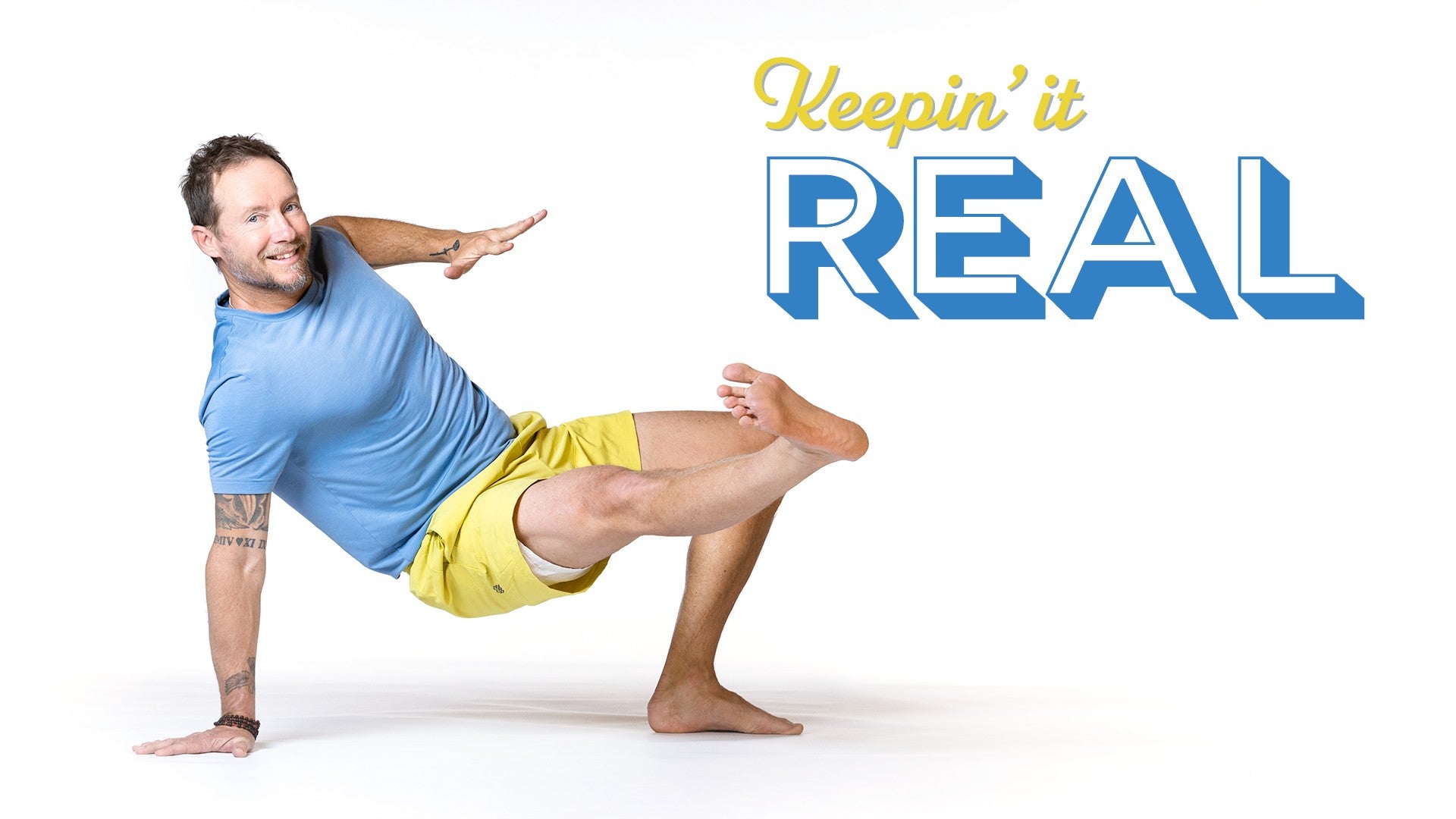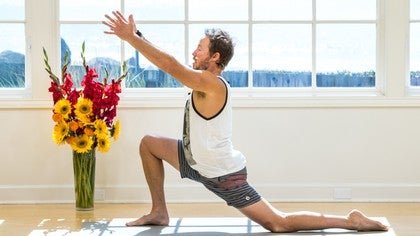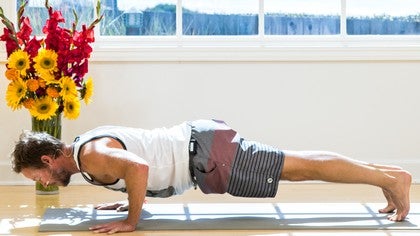Description
About This Video
Transcript
Read Full Transcript
Hey, how you doing? Welcome to Yoga Anytime. Let's talk about the pelvis and how the pelvis is or works in relationship with low lunge and high lunge. Yeah, let's do that. All right.
So my understanding of this, right, is if I stand to the side, you want to join me here, a lot of us, well, take the hands on the hips, okay, soft little bend in the knees, and like you're dialing your waist forward, sticking your butt out, okay. Now if you keep that butt out and your legs straight, and then you try to like lift your body, you might feel some really unnecessary discomfort in your low back, maybe, maybe not, might feel really good to you, I don't know. But what I want to work with is getting the pelvis into less of this, which is anterior tilt, more into a neutral, okay. So maybe get a visual here, right. I'm going to take my left hand right around my pubic bone below my navel, my right hand to my low back and tailbone.
Now as you're doing it, watch the screen and just see if you can get a sense of the difference. Do that a couple times. So tailbone, press it back and up, feel the low back. And also the belly, can you feel the belly and how the core just sort of like, okay, which is appropriate for certain things, but not for what we're working with here. Now here, lift with the left hand, lift the pubic bone and press down with the right hand, press the tailbone down and lengthen through the low back.
Can you feel that? Okay. So that's what I want you to pay attention to as we come down into low lunge. All right. So take your left foot, step it back.
Okay. So we're going to start first with a really long lunge. You bring your left foot, your left leg back quite a bit. Take the right foot, you know, the usual before under the knee. Now it's fine here.
My hands are down to frame that right foot. I'm not lifting my chest, so my back is actually fine. My low back is fine. Okay. How does yours feel?
Check in with that. Now the other thing I'm not that concerned about here is having my core or my low belly like crazy engaged. That's not that important to me right here. But when we're asked to come up into a low crescent lunge, okay, really feel your way into this. Reach your arms up, drive your hips forward, right?
Lift your chest, lift your arms. Now can you remember where we were standing and how the pelvis kind of tips forward here and then you're asked to lift up and back. So the low back may be getting a little bit of a squeeze. Now here, if I told you tuck your tailbone or extend your tailbone, you can't. It's locked down.
Okay. It's like too much pressure, let's say. So what I like to work with, okay, and again, this may be, you may be the back bend queen or king and this just feels amazing. Great. Try this as well just for a different experience.
Okay. Take your left knee forward so that you have your left leg in a 90 degree angle and your right leg in a 90 degree angle. Okay. So here before when I asked or I said hypothetically, if we were asked to tuck or extend or move your pelvis, it wasn't happening. Now I can really manipulate the pelvis easily because the pressure is now released.
Okay. So first part of this little thing here is for you to find that neutral position. So it may be helpful for you to find the extreme version first, which is anterior forward tilt tailbone, lifting up and back pubic bone, lowering. And then if you lift it here, it'd be like, ah, right? Not that great.
But if you bring your hands down, shift the pelvis into a neutral position, neutral arms up spine is healthy and long. Okay. That's the one benefit. No compression in the back. The next benefit is this real genuine stretching and lengthening up through.
In this case, if your right foot is forward, like mine, your hip flexor region in your hip, right? Your waist. There's some lengthening and stretching happening through there, especially if you engage your glutes to do it. So it's like a hands-free kind of squeezing of the butt, just enough to draw the tailbone down. You might feel a really long stretch up through the quad hip flexor.
And then if you lift your arm up all the way up, okay, the last little benefit, there's two other little pieces here. Those are the two main. The other one is when you do bring that pelvis into a neutral position, your core does become more active. Okay. The low belly engages.
The next one is, is when you stretch, when hip flexors are really super tight, which a lot of us sit a lot and they get shortened or like really tight, they're like this, right? So your hamstring on that leg, back leg is really unnecessarily long. So if you can imagine like extending the tailbone down and really stretching long through the waist, the hip flexors, that hamstring might be able to relax, okay? So those are some of the key things I find important and valuable in a low lunge and they can be applied to a high lunge as well. So I'm going to switch legs because I was there forever and so were you.
So just take a moment to address it again. Tailbone down, down in the direction of your heel, right, or the calf of the right leg. Belly's engaged a little bit, right? You can take any arm variation, that's not really what we're talking about here, but neutral pelvis, neutral pelvis, neutral pelvis is a win, win, win, win, I think. And also from here, you know, with it kind of drawn downward, you keep that action as you lean into it, you just have that awareness of when it's not or no longer neutral, okay?
So you can make that call when you're in a pose, all right, well this isn't the pose I want it to be neutral in, I want to kind of get all bendy in my low back, okay? So one, let's take just a quick visual and how it looks in a high lunge. So I'll go with my left foot forward, maybe you can see better with the right foot forward. So similar concept, right? Okay, you've just stepped up, you've got this really long stance and it's inhale lunge.
Here we go, low back again, core is just like, that's what you want, cool. Or shorten your stance a little bit, okay? This relieves the pressure here so that you can draw the tailbone down, get that like whoa stretch up through the hip flexor which definitely happens, okay? Low back extended, no compression, everything's neutral, everything's firing, healthy, strong and then you take whatever arm variation, right, okay? If you can, you keep this position, pelvis neutral, you can work towards straightening that left leg, no doubt, might be available, it might not, okay?
So make sure to do that on both sides, that's the pelvis in high lunge and low lunge. I hope it's helpful for you, thanks for joining me, have a great day.
Keepin' it Real
Comments
You need to be a subscriber to post a comment.
Please Log In or Create an Account to start your free trial.









